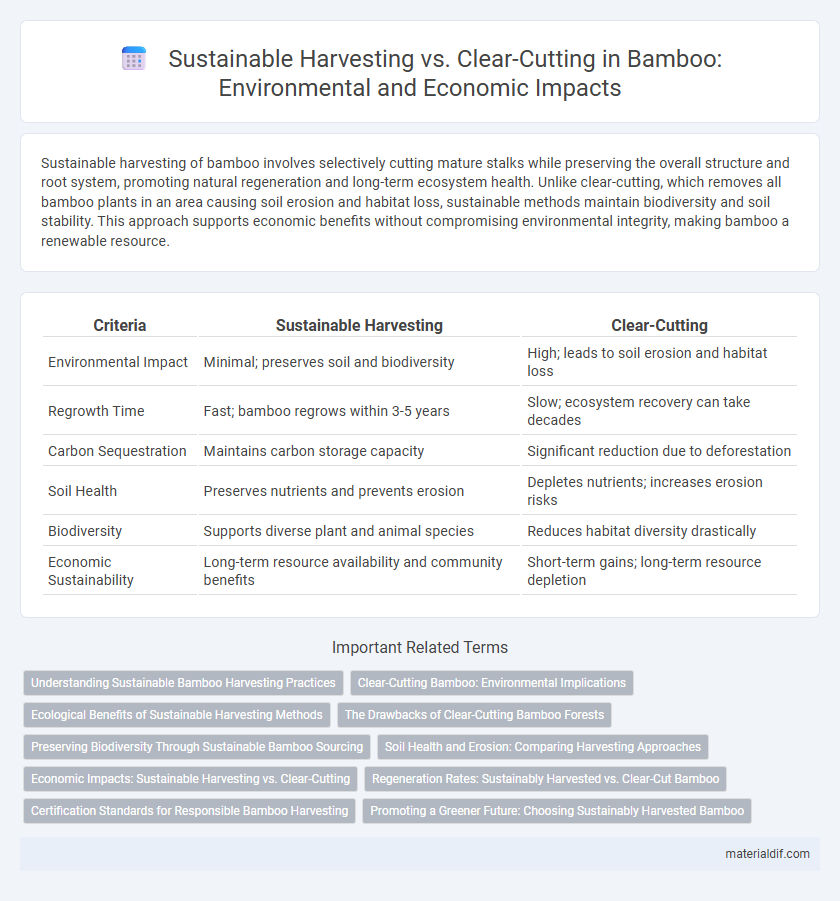Sustainable harvesting of bamboo involves selectively cutting mature stalks while preserving the overall structure and root system, promoting natural regeneration and long-term ecosystem health. Unlike clear-cutting, which removes all bamboo plants in an area causing soil erosion and habitat loss, sustainable methods maintain biodiversity and soil stability. This approach supports economic benefits without compromising environmental integrity, making bamboo a renewable resource.
Table of Comparison
| Criteria | Sustainable Harvesting | Clear-Cutting |
|---|---|---|
| Environmental Impact | Minimal; preserves soil and biodiversity | High; leads to soil erosion and habitat loss |
| Regrowth Time | Fast; bamboo regrows within 3-5 years | Slow; ecosystem recovery can take decades |
| Carbon Sequestration | Maintains carbon storage capacity | Significant reduction due to deforestation |
| Soil Health | Preserves nutrients and prevents erosion | Depletes nutrients; increases erosion risks |
| Biodiversity | Supports diverse plant and animal species | Reduces habitat diversity drastically |
| Economic Sustainability | Long-term resource availability and community benefits | Short-term gains; long-term resource depletion |
Understanding Sustainable Bamboo Harvesting Practices
Sustainable bamboo harvesting involves selectively cutting mature stalks while preserving the overall biomass, allowing the plant to regenerate naturally and maintain soil stability. This practice contrasts with clear-cutting, which removes all bamboo indiscriminately, leading to habitat loss, soil erosion, and reduced carbon sequestration. Implementing sustainable methods supports biodiversity, promotes long-term yield, and contributes to environmental conservation goals.
Clear-Cutting Bamboo: Environmental Implications
Clear-cutting bamboo leads to significant environmental degradation, including loss of biodiversity and soil erosion due to the removal of entire bamboo stands. This practice disrupts local ecosystems by reducing habitat availability for wildlife and increasing vulnerability to invasive species. Sustainable harvesting methods, by contrast, preserve bamboo's regenerative capabilities and maintain ecological balance.
Ecological Benefits of Sustainable Harvesting Methods
Sustainable bamboo harvesting preserves root systems and promotes continuous growth, preventing soil erosion and maintaining biodiversity in bamboo forests. Unlike clear-cutting, which destroys habitats and depletes resources, selective harvesting supports carbon sequestration and enhances ecosystem resilience. These ecological benefits contribute to long-term environmental health and sustainable resource management.
The Drawbacks of Clear-Cutting Bamboo Forests
Clear-cutting bamboo forests leads to significant soil erosion, loss of biodiversity, and disruption of local ecosystems due to the removal of all vegetation. This unsustainable practice depletes soil nutrients, hinders natural regeneration, and increases vulnerability to pests and diseases, compromising long-term bamboo productivity. Sustainable harvesting methods maintain forest structure, promote ecological balance, and ensure continuous bamboo supply without degrading the environment.
Preserving Biodiversity Through Sustainable Bamboo Sourcing
Sustainable bamboo harvesting involves selective cutting techniques that maintain the forest structure and promote regrowth, preserving habitat diversity and supporting local wildlife populations. Unlike clear-cutting, which eliminates entire areas and disrupts ecosystems, sustainable sourcing ensures the continuity of plant and animal species and maintains soil health. This approach enhances carbon sequestration capabilities and reduces environmental degradation, contributing to long-term biodiversity conservation.
Soil Health and Erosion: Comparing Harvesting Approaches
Sustainable bamboo harvesting preserves soil health by maintaining root structures that prevent erosion, whereas clear-cutting removes entire bamboo stands, leaving soil exposed and vulnerable to degradation. The dense root networks in sustainably managed bamboo forests stabilize soil, reduce runoff, and enhance water retention, promoting long-term ecosystem balance. In contrast, clear-cutting disrupts these natural processes, increasing the risk of soil erosion and nutrient loss, which can degrade land productivity and biodiversity.
Economic Impacts: Sustainable Harvesting vs. Clear-Cutting
Sustainable harvesting of bamboo promotes long-term economic stability by ensuring continuous resource availability and supporting local economies through ongoing job creation and market demand. In contrast, clear-cutting provides short-term financial gains but leads to resource depletion, loss of biodiversity, and diminished ecosystem services, resulting in economic losses over time. Investing in sustainable bamboo management enhances profitability by balancing ecological health with steady supply chains and community well-being.
Regeneration Rates: Sustainably Harvested vs. Clear-Cut Bamboo
Sustainably harvested bamboo maintains high regeneration rates due to selective cutting methods that preserve root systems and mature shoots, enabling quick regrowth within three to five years. In contrast, clear-cutting bamboo disrupts root networks, significantly slowing regeneration and increasing soil erosion risks, which can delay forest recovery for over a decade. Sustainable practices also promote continuous biomass supply and support biodiversity, making them more viable for long-term ecosystem health compared to the destructive nature of clear-cutting.
Certification Standards for Responsible Bamboo Harvesting
Certification standards such as FSC (Forest Stewardship Council) and PEFC (Programme for the Endorsement of Forest Certification) ensure responsible bamboo harvesting by promoting sustainable management practices that maintain biodiversity and soil health. These certifications require selective harvesting techniques rather than clear-cutting, which prevents ecosystem disruption and supports long-term resource availability. Compliance with these standards also guarantees traceability and social accountability within bamboo supply chains.
Promoting a Greener Future: Choosing Sustainably Harvested Bamboo
Sustainably harvested bamboo preserves the natural ecosystem by allowing selective cutting that encourages regrowth and maintains soil health, unlike clear-cutting that leads to deforestation and biodiversity loss. This method supports carbon sequestration, enhances habitat protection, and reduces environmental impact by minimizing waste and disruption. Choosing sustainably sourced bamboo fosters a greener future through responsible resource management and long-term ecological balance.
sustainable harvesting vs clear-cutting Infographic

 materialdif.com
materialdif.com